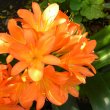| Botanical Name |
|
| Family |
Amaryllidaceae - The amaryllis family. |
| Pronunciation |
|
| Common Name(s) |
|
| Plant Group |
- Bulb / Corm / Rhizome / Tuber / Epigeal bulb Bulbs: are made up of fleshy scales as in an onion
Corm: a short, swollen, underground stem that is hard and not fleshy as in a gladiolus
Tuber: a solid, fleshy, underground, storage organ as in a potato
Rhizome: an underground, horizontal, swollen stem at the base of the plant as in an iris
Epigeal bulb: bulbs that rest above the ground with only the roots anchoring the plant to the earth as in albuca
- Ground Cover A plant with a low-growing, spreading habit, grown specifically to cover the ground.
|
| Plant Size |
- Medium
| Tree | 10m to 16m |
| Shrub | 1m to 2m |
| Perennial/ground cover | 40cm to 60cm |
| Bulb | 40cm to 60cm |
| Succulent | 40cm to 60cm |
|
| Position |
- Canopy Shade Canopy shade is found below closely grown trees where some light filters through. Ideal for the protection of herbaceous plants.
- Deep / Full Shade Shade below spreading evergreen trees where sun's rays are unable to penetrate the canopy at any time. For light sensitive plants
- Dry Shade Shady areas where soil has poor water retention or are dependent on rain for their moisture needs.
- Light or Dappled Shade Found below trees with sparse, open foliage. Ideal for the protection of herbaceous plants.
|
| General Information |
- Attractive fruits, berries or seeds Brightly coloured fruits or berries increase and extend the visual impact of the plant and are especially attractive to birds and other small wildlife.
- Drought Tolerance: Moderate The plant is moderately adapted to arid conditions and can survive short periods of drought and high temperatures without extra water.
- Evergreen Plants that have leaves all year round.
- Frost: Tender A plant that will not survive any frost or low winter temperatures.
- Water Loving Plants need a regular supply of water and must not be allowed to dry out for any length of time.
|
| Specific Information |
For over a century, Clivia miniata has been cultivated and crossbred around the world, resulting in a vast variety of colour, size and shape. These bulbs grow from a tuberous rhizome (which is highly toxic) from which a mass of thick roots grow. The shiny, green strap shaped leaves arise from the ground and form a dense clump and show off the resplendent flowers most admirably. Many of the large colonies growing in their natural habitat have been decimated by over harvesting by plant collectors.
Mole-rats, (not Moles), are partial to clivia and if you are plagued by these pesty little mammals it is best to consider keeping these bulbs in a container.
|
| Ad Break |
|
| Flowers |
| Description |
up to 16 funnel-shaped flowers 6-8cm in length, in a rounded head on a sturdy stem
|
| Season |
- Winter to Spring Plants will seldom bloom for the entire season as given in the list, but should flower during a period within these parameters.
|
| Colour |
|
| Growth Rate |
- Slow to Moderate Specifying growth rate can be very misleading as there is considerable variation of growth rate depending on type and species of plant, available water, supplementary feeding, mulching and general care, as well as the plants suitability and adaptability to the garden environment.
|
| Plant Uses |
- Accent or Focal Point A plant used to attract the attention because of its colour or form.
- Attracts bees, butterflies or other insects This plant attracts insects which can be food for birds or other creatures in your garden.
- Attracts Birds This plant will attract birds.
- Border A strip of ground, at the edge of a driveway or path in which ornamental plants or shrubs are planted.
- Container Trees, shrubs and ornamental species that can adapt to growing in a restricted environment.
- Ground Cover Low-lying plants that spread fast, require minimal maintenance, and cover large expanses or bare areas between bulbs or shrubs. They provide protection from erosion and drought and improve the visual appearance of the garden.
- Mass Planting Plants useful for filling a large area with just one or a few kinds of plants spaced close together. Creates a bold, dramatic effect and to reduces maintenance.
- Pot Plant A plant that needs a protected environment on a patio or indoors.
- Suitable for coastal gardens Plants adapted to dry, sandy soil, forceful wind, limited rainfall and intense sunlight.
- Water Features These plants may have dramatic, lush foliage or graceful form. They do not shed excessive leaves and do not have invasive root systems.
|
| Distribution and Habitat |
from the Eastern Cape Province to Kwazulu-Natal, Mpumalanga and Swaziland, in subtropical coastal forest and ravines in high altitude forest
|
| Planting Suggestions |
Plant in full or dappled shade with plenty of compost and mulch, and water regularly during spring and summer. Feed and compost during the summer months for better results. Watering can be greatly reduced during the winter months, when the plants are at rest.If planted in containers make sure the soil is well drained and rich in compost. Use a liquid fertiliser to keep them well fed. Although they need good air circulation, cold winds will cause serious, long term damage so make sure they are placed in a sheltered position. The best method of propagation is to split up the clumps but bear in mind that Clivias resent being moved and can take up to two years to flower after being separated. Do not lift them until they are over-crowded and show signs of stress, such as reduced flower quality and quantity - or a cracked container!
If you are prepared to wait for a few years until they flower, Clivias can be grown from seed. When you are ready to sow, remove the pulp from the pearly white seeds and plant in a deep tray (they will stay there for two years), filled with a sterilised seedling mix. Press the seeds gently into the mix, just level with the soil surface and keep an eye out for algal growth on the soil surface. Seeds will germinate in four to six weeks.
Go here for advice to improve flowering.
|
| Medicinal Uses |
The rhizomes of clivias are toxic and the use of them is not encouraged. At low doses, ingestion causes salivation, vomiting and diarrhoea, while higher doses result in paralysis and collapse. Preparations of parts of the plant are used to start delayed labour and facilitate delivery.
|
| Ad Break |
|








Comments
clivias
My Clivias are being destroyed by caterpillars. It is the first time I have seen them in my garden. How can I get rid rid of them?
Lily borer on Clivia
Hi Maria
As you have not given me a description of the caterpillars, I am guessing that the caterpillars you are seeing are Lily borers: yellow to pale yellow with black bands. You can get rid of them by picking them off or by using an environmentally friendly pesticide like Margaret Roberts Biological Caterpillar Insecticide. Alternatively you can also use chemical poisons but be aware that these poisons will kill or damage most of the wildlife in the immediate area, including bees, praying mantises, frogs and toads, birds visiting the flowers for nectar and so on. If you wish to make use of these poisons, you can get information about them from your nursery or hardware store.
Kind regards
Lorraine
Clivias
thank you very much for your help, I will be using Margaret Roberts' Biological Insecticide, I did use Flea Powder, that was the only thing I had at the moment, I was sacred of loosing my beautiful Clivias, and I did pick them by hand, but the eggs were all over the leaves, thank you once again
Maria's Clivias
Hi Maria
Let me know how the insecticide works. You can also get rid of many insect eggs by hand by using a pair of plastic gloves. Stroke the leaf firmly but gently between your thumb and forefinger, thus removing and squashing the eggs. I find this a bit sickening but it is quick, effective and safe.
Kind regards
Lorraine
Discuss this plant
Share knowledge, ask a question or give an experience.